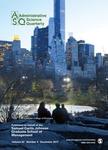-
作者:HAVEMAN, HA
摘要:This paper examines the relationship between organizational size and change. If organizational size indicates political insulation and degree of bureaucratization, then large organizations will change less than small organizations. If organizational size is related to the possession of slack resources, differentiated and decentralized structures, and market power, however, then large organizations will be more fluid than small organizations. I tested these hypotheses by modelling rates of chan...
-
作者:GARGIULO, M
摘要:This paper proposes an alternative to resource-dependence approaches to strategic behavior, which predict that actors seek direct cooptive relations to alleviate constraint. I propose that an actor can gain leverage on a limiting party by building a cooptive relation with a player that may control this party's behavior, thus using two-step leverage. Data on dependence relations, political alliances, and confidential discussion networks among decision makers in a cooperative agribusiness furnis...
-
作者:PALMER, DA; JENNINGS, PD; ZHOU, XG
作者单位:University of British Columbia; Cornell University
摘要:This paper presents a refined test of the institutional, political, and economic accounts of adoption of the multidivisional form (MDF) among large U.S. industrial corporations in the 1960s, most notably by elaborating the institutional account. Results suggest that institutional processes, including coercive and normative dynamics, substantially underpinned the MDF's diffusion during the 1960s. Firms producing in industries that shunned the MDF earlier in this century were slow to adopt this ...
-
作者:ALEXANDER, JA; FENNELL, ML; HALPERN, MT
作者单位:Pennsylvania Commonwealth System of Higher Education (PCSHE); Pennsylvania State University; Pennsylvania State University - University Park; University of Michigan System; University of Michigan
摘要:This study tested whether leadership instability-a systemic pattern of frequent succession in the top management position of an organization-was associated with sociopolitical structures that define the relationship between the board and chief executive officer (CEO), controlling for temporal patterns of the organizational life-cycle stage. In organizations that are not profit maximizing and subject to considerable uncertainty, such governance properties were hypothesized to affect leadership ...


